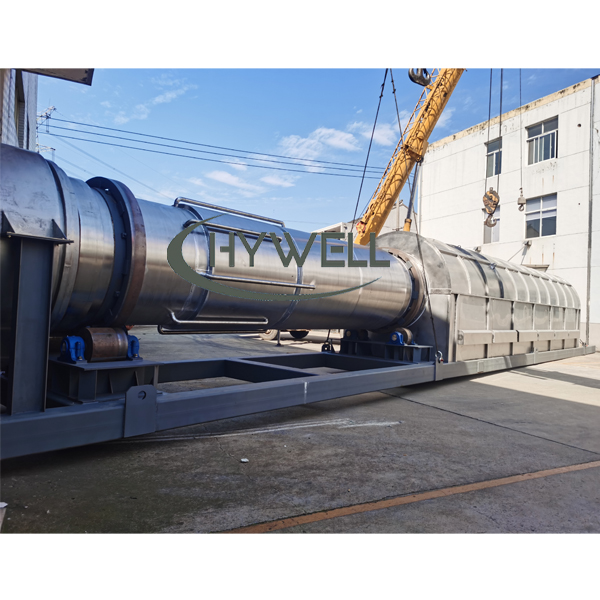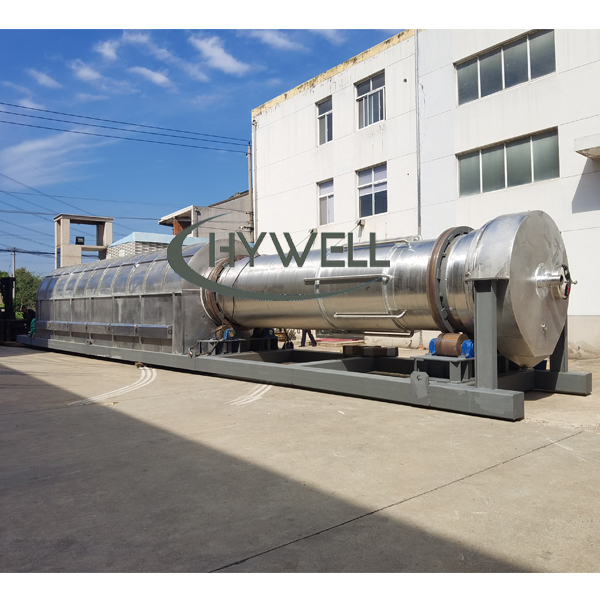This Battery Recycling Rotary Kiln is purchased from a new energy factory in China and the rotary kiln is mainly used for recycling and calcining battery cathode materials. 3 months to produce and pass factory FAT and arrange delivery to client site.
Battery Recycling Rotary Kiln Specification
Output of rotary kiln: 600-800kg/h
Heating method: electric heating
Processing material: powder material
Processing atmosphere: nitrogen, oxygen, argon
Temperature of working:1000-1100C
Applicable materials: recycling and calcination of lithium battery materials, positive electrode materials, and negative electrode materials.

Rotary kiln

Rotary calciner

Rotary calciner
Shipped Battery Recycling Rotary Kiln highlights
(1) The material is calcined under the condition of -70kPa by the rotary dryer.
(2) The material roasting temperature of the rotary kiln can be set arbitrarily between room temperature and 1050 °C, the heating temperature in the furnace is uniform, and there must be no section lower than the roasting temperature.
(3) After the material is roasted, all the material can be unloaded from the discharge end, and it is required that the discharge end to the discharge tank should not be in contact with the air during the operation.
⑷ The material enters the roasting furnace and is continuously fed through the switching of the two feeding tanks. After the material is roasted, the material is discharged continuously through the switching of the two discharging tanks. The inlet and outlet valves are all pneumatic valves.
(5) After calcination, the rotary dryer is equipped with a material cooling device, and the discharge temperature is lower than 80 degrees.
Application of the Battery Recycling Rotary Kiln?
The battery materials rotary dryer main use to Lithium battery, battery anode material, battery negative electrode material, battery recycled anode material, battery recycled negative electrode material, etc.
This Lithium Battery Recycling Powder Rotary kiln is currently mainly used in the waste battery recycling industry produced by electric vehicles. Battery recycling will require high-temperature calcination of recycled materials. According to different material processes, the calcination temperature of the high-temperature rotary kiln is usually 700 degrees to1100 degrees. Moreover, the calcination time of the rotary drum calciner can also be set according to various techniques and materials. Depending on the calcination temperature, the thickness and material of the insulation layer are very important, because the high temperature of the Rotary Calciner cannot be transmitted to the surface of the rotary forging furnace, which not only increases the energy consumption but also increases the danger to the staff.
How to ensure accurate control of material calcination temperature by the Battery Recycling Rotary Kiln?
(1). The Battery Recycling Rotary Kiln is divided into six heating zones or heating sections (zone control, but the furnace is not partitioned).
(2). Set 6 temperature measuring points, the measured values are sent to the control cabinet and output to control the heating power of the furnace. The gradient control method is used to continuously adjust to achieve the purpose of controlling the furnace temperature. 1 material temperature measurement point.
(3). The temperature rise of the surface of the two side walls of the rotary drum kiln shall not exceed 45℃, and the temperature rise of the surface of the furnace top shall not exceed 45℃.
(4) The Battery Recycling Rotary Kiln insulation adopts the combination of refractory bricks and high-temperature refractory fibers. The bottom of the furnace adopts refractory fibers + refractory bricks, the side walls of the furnace are insulated with refractory fiber folded blocks, and the top of the furnace is insulated with circular arch structure and trapezoidal folded blocks.
(5).The Battery Recycling Rotary Kiln is equipped with a special on-site control cabinet, and all detection and control signals enter the on-site control cabinet.
How to ensure the calcination time inside the Battery Recycling Rotary Kiln?
All the spiral plates of the battery rotary kiln are used in the drum to replace the copying plates, and the spiral plates are all linked together. This rotary kiln does not need to use an angle, and all materials are propelled by a spiral plate. The residence time of the material is completely determined by the rotation speed of the spiral plate. The main transmission motor adopts frequency conversion control. Inverter adopts the famous brand
Battery Recycling Rotary Kiln Delivery Video
Introduction to Battery Recycling Rotary Kilns
A rotary kiln is a large, cylindrical, rotating furnace that is used to heat solids to a very high temperature in order to bring about a chemical reaction. The solids are fed into the kiln at one end and gradually move toward the other end as the kiln rotates. The process can take several hours or even days, depending on the application.
Design and Construction of Rotary Kilns
Kiln Shell
The kiln shell is the main body of the battery recycling rotary kiln. It is made of a steel plate and is lined with refractory materials to protect it from the high temperatures inside the kiln.
Riding Ring
The riding ring is a steel ring that supports the kiln shell and allows it to rotate. It is mounted on rollers or tires that support the weight of the kiln.
Kiln Tyre
The kiln tire is a steel ring that is mounted on the riding ring. It supports the weight of the kiln and ensures that it rotates smoothly.
Kiln Drive
The kiln drive is the mechanism that rotates the kiln. It can be driven by a motor or by a gear and pinion system.
Burners
Burners are used to heat the material inside the kiln. They are typically fuel.
Battery Recycling Rotary Kiln: A Sustainable Solution for Waste Management
Battery recycling has become increasingly important in recent years as the negative impact of batteries on the environment and the risks associated with their improper disposal have become more evident. The rotary kiln technology is a sustainable solution for battery waste management as it not only reduces waste but also produces valuable materials and has a lower carbon footprint.
The rotary kiln process involves the thermal decomposition of materials at high temperatures. In the case of battery recycling, this process results in the extraction of valuable metals such as lead, lithium, nickel, and cobalt. The preparation of batteries for recycling involves crushing and shredding them into smaller pieces. These pieces are then fed into the rotary kiln where the thermal decomposition process takes place. The valuable metals are extracted from the resulting ash using various techniques.
The benefits of battery recycling rotary kilns go beyond the production of valuable materials. They also contribute to sustainable waste management by reducing the amount of waste sent to landfills and lowering carbon emissions. Furthermore, sustainable waste management has environmental, economic, and social benefits.
The future of battery recycling rotary kilns is bright as innovation in the industry continues to drive down costs and increase the efficiency of the technology. However, there are still challenges that need to be addressed such as the high capital cost, safety concerns, and technical challenges.
In conclusion, battery recycling rotary kilns offer a sustainable solution for waste management that not only reduces waste and lowers carbon emissions but also produces valuable materials. It is important for businesses and consumers to contribute to sustainable waste management efforts and for governments to implement regulations and policies that support these efforts.
FAQs
What are the benefits of battery recycling rotary kilns?
Battery recycling rotary kilns reduce waste, produce valuable materials, and have a lower carbon footprint compared to traditional waste management methods.
What materials can be extracted from recycled batteries?
Valuable metals such as lead, lithium, nickel, and cobalt can be extracted from recycled batteries using the rotary kiln process.
What are the different types of rotary kilns used for battery recycling?
There are several types of rotary kilns used for battery recycling.
Introduction
Battery Recycling: Preserving the Environment, One Cell at a Time
In our modern world, batteries power our lives, from portable electronics to electric vehicles. However, improper disposal of batteries can lead to serious environmental consequences. Toxic chemicals and heavy metals present in batteries can leach into soil and water, polluting ecosystems and posing risks to human health. Battery recycling is the key to mitigating these environmental hazards and ensuring a sustainable future.
High-Temperature Treatment: A Promising Solution
High-temperature treatment is an innovative approach to battery recycling that involves subjecting batteries to elevated temperatures in a controlled environment. By utilizing rotary kilns, a type of industrial furnace, this method can efficiently extract valuable materials from used batteries while minimizing waste and environmental impact.
Understanding Battery Recycling
The Environmental Impact of Improper Battery Disposal
When batteries end up in landfills or are incinerated, they release harmful substances into the environment. Heavy metals such as lead, mercury, and cadmium can contaminate soil, water, and air, posing a significant threat to ecosystems and human health. Battery recycling helps prevent these pollutants from entering the environment and facilitates the recovery of valuable resources.
The Need for Efficient Battery Recycling Methods
Traditional battery recycling methods often involve manual disassembly and chemical leaching, which can be labor-intensive and environmentally challenging. High-temperature treatment.
High-Temperature Treatment for Battery Recycling by Rotary Kiln
Battery recycling plays a vital role in preserving the environment and conserving valuable resources. With the increasing use of batteries in various applications, it becomes imperative to find efficient and sustainable methods for their recycling. One such method gaining traction is high-temperature treatment using rotary kilns. In this article, we will explore the concept of high-temperature treatment for battery recycling and delve into the advantages and processes involved.
English
Русский
العربية
Français
Español
Português
Deutsch
italiano
日本語
한국어
Nederlands
Tiếng Việt
ไทย
Polski
Türkçe
ພາສາລາວ
Bahasa Melayu
Filipino
Bahasa Indonesia
magyar
Română
Čeština
қазақ
Српски
हिन्दी
فارسی
Slovenčina
Slovenščina
Norsk
Svenska
українська
Ελληνικά
Suomi
Հայերեն
עברית
Dansk
اردو
বাংলা
Hrvatski
Afrikaans
Gaeilge
Eesti keel
Māori
नेपाली
Oʻzbekcha
latviešu
Azərbaycan dili
Беларуская мова
Български
ქართული
Kurdî
Кыргызча

 简体中文
简体中文






